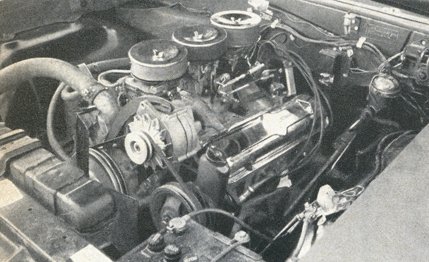In 1963 we were a bit stunned by a Mercury Marauder that had 427 cubic inches, 425 horsepower, good handling, and performance that, to us, was absolutely breathtaking. The Tempest GTO is better. First of all, its smaller outside dimensions make it a lot more fun to drive; and, second, it goes faster.
Our test car was equipped with the 389-cubic-inch, 348 horsepower, V-8 engine with hydraulic valve lifters and a compression ratio of 10.4 to one. It had the new GM “Muncie” four-speed transmission and Pontiac’s Saf-T-Trak limited-slip differential. The rear axle ratio was 3.90 to one, and the brakes had metallic linings. The car had standard Tempest GTO suspension (slightly stiffer valving in the shocks) and manual steering with an overall ratio of 20 to 1, substantially faster than the standard manual steering ratio of 26 to 1, but slower than the power steering’s 17 to 1. We preferred the power steering—not because the manual set-up was too stiff, but because it still wasn’t quite fast enough.
|
|
A word of caution here: Pontiac is forced by the realities of commerce to build cars for little old ladies and GM executives as well as enthusiasts. It is quite possible to go to your dealer’s for a demonstration drive and find yourself in a GTO of infinite dullness—an automatic-transmission-, power-operated-seat-, tinted-window-car with little to distinguish it from a Chevelle, a Buick Special, an Olds F85, or any other semi-visible American car. The GTO that delights the executive from the fourteenth floor of Detroit’s General Motors Building is not going to be the rabid enthusiast’s dish of tea. To buy a car like our test car you should either get hold of a catalog and memorize the options you want, or seek out a live-wire dealership like Royal Pontiac in Royal Oak, Michigan, the firm that loaned us our GTO.
Royal is run by a man named Ace Wilson, who must be what regional sales managers ask Santa Claus to bring them for Christmas. His dealership is big and bright, with clean modern architecture and a whole staff of knowledgeable salesmen and mechanics. Royal is Pontiac performance headquarters, and a Royal license plate frame on your GTO or Grand Prix is enough to send teenagers into orbit anywhere in the United States. Royal even has its own line of accessories and speed equipment, certain combinations of which give the proud GTO or Catalina owner the right to call his car a Royal Bobcat, and to fit it with small black and white emblems to that effect.
|
|
Our test cars were Bobcats. This means that they were basically stock Tempest GTO’s with the following changes:
1. The main jets were changed to .069 in on all three carburetors for maximum acceleration. Normally, the center carburetor runs lean (.066 in) for cruising economy, with rich jets (.073 in) on the outboard carburetors for occasional bursts of speed. The Royal treatment gives a more even mixture distribution at a slight increase in steady-speed gas consumption.
2. A progressive-action throttle linkage is installed to calm the beast down for boulevard use; it’s also more accurate than the stock linkage.
3. The distributor is modified to limit centrifugal advance to 7° (14 crankshaft degrees) and initial advance is set at a whopping 20–22° (total advance, 34–36°, is reached at 3600 rpm). This makes a tremendous improvement in low-end response (i.e., below 3600 rpm) but substantially raises the octane requirement.
4. The heat riser is blocked off, a special (thin) head gasket from the Super-Duty 421 engine is installed and still more compression is gained by installing Champion J-10Y plugs without gaskets.
5. Finally, special fiber-insert rocker arm retaining locknuts are installed which permit the hydraulic lifters to function as a solid lifter—operating at 90% bleed-down.
As you can see, these changes are neither extensive nor complicated, and fall more into the area of maximum tuning than of modification or “hopping up.” The net result is an enormously strong engine with the capacity to spin its rear wheels in every gear, in spite of a limited-slip differential! The only penalty we noticed was that the car would knock like twenty-five poltergeists at a seance when anything but Sunoco 260 premium fuel (about 102 octane) was used.
View Photos
View Photos


Leave a Reply